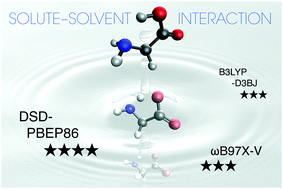How accurate are approximate quantum chemical methods at modelling solute–solvent interactions in solvated clusters?†
Abstract
In this paper, the performance of a wide range of DFT methods is assessed for the calculation of interaction energies of thermal clusters of a solute in water. Three different charge states (neutral, proton transfer transition state and zwitterion) of glycine were solvated by 1 to 40 water molecules as sampled from molecular dynamics simulations. While some ab initio composite methods that employ insufficiently large basis sets incurred significant errors even for a cluster containing only 5 water molecules relative to the W1X-2 benchmark, the DLPNO-CCSD(T)/CBS and DSD-PBEP86 (triple zeta basis set) levels of theory predicted very accurate interaction energies. These levels of theory were used to benchmark the performance of 16 density functionals from different rungs of Jacob's Ladder. Of the Rung 4 functionals examined, the ωB97M-V and ωB97X-V functionals stood out for predicting absolute interaction energies in 40-water clusters with mean absolute deviations (MAD) ∼4 kJ mol−1. The B3LYP-D3(BJ) functional performed exceptionally well with a MAD ∼1.7 kJ mol−1 and is the overall best performing method. Calculations of relative interaction energies allow for cancellation of systematic errors, including basis set truncation and superposition errors, and the ωB97M-V and B3LYP-D3(BJ) double zeta basis set calculations yielded relative interaction energies that are within ∼3 kJ mol−1 of the benchmark. The ONIOM approximation provides another strategy for accelerating the calculation of accurate absolute interaction energies provided that the calculations have converged with respect to the size of the “high-level-layer”.

- This article is part of the themed collection: 2020 PCCP HOT Articles


 Please wait while we load your content...
Please wait while we load your content...